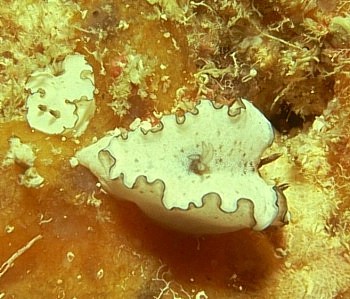

Glossodoris paladentatus
Rudman, 1986
Order: NUDIBRANCHIA
Suborder: DORIDINA
Superfamily: EUDORIDOIDEA
Family: Chromodorididae
DISTRIBUTION
Known only from Papua New Guinea and Vanuatu.
PHOTO
UPPER: Holotype and Paratype specimens, 13,6mm long preserved. Milne Bay, Papua New Guinea, April 1982. PHOTO: N. Coleman.
LOWER: Espiritu Santo Is., Vanuatu, 20 mm long. PHOTO: Vinka Stenhouse.
Previously known only from the original two specimens from Papua New Guinea, it is reported below from Vanuatu.
Superficially very similar in colour to Glossodoris atromarginata it differs in having scattered brown blotches over the mantle, and whitish gills lined with black or dark brown. There is also a submarginal bluish band around the mantle edge. The radula of this species is quite unusual, the innermost tooth in each halfrow having a wide spade-like blade which gives the species its name. Both photos seem to show animals feeding on the same species of sponge.
Reference:
• Rudman, W.B. (1986) The Chromodorididae (Opisthobranchia: Mollusca) of the Indo-West Pacific: the genus Glossodoris Ehrenberg (=Casella, H.& A. Adams). Zoological Journal of the Linnean Society, 86: 101-184.
Rudman, W.B., 1999 (November 20) Glossodoris paladentatus Rudman, 1986. [In] Sea Slug Forum. Australian Museum, Sydney. Available from http://www.seaslugforum.net/find/glospala
Related messages
Glossodoris paladentatus from Vanuatu
February 27, 2003
From: Vinka Stenhouse

Bill
We found another Glossodoris paladentatus at almost the same location as the previous one we saw 4 years earlier. Depth of 16m crawling over sponge. 2/02.
Vinka
vinkas@oceanaphotography.com


Thanks Vinka,
Some of these species are a bit difficult to be sure of without extracting their teeth, but from your photo I am pretty sure of your identification. Certainly an interesting find.
Best wishes,
Bill Rudman
Glossodoris paladentatus? from South Africa
April 1, 2000
From: Valda Fraser


Dear Bill
Something to cheer me up - a nudibranch that I haven't seen before! Please tell me what it is.
Locality: South coast KwaZulu-Natal SOUTH AFRICA. Park Rynie - 34m
Date: March 2000
Size: 50mm
Regards
Valda Fraser
iti04937@mweb.co.za
Fraser, V., 2000 (Apr 1) Glossodoris paladentatus? from South Africa. [Message in] Sea Slug Forum. Australian Museum, Sydney. Available from http://www.seaslugforum.net/find/2163
Dear Valda,
Your animal looks very like Glossodoris atromarginata in shape but rather different in colour. I have posted in a separate message an east African Glossodoris atromarginata which has some white mottling.
What your animal looks like in colour is Glossodoris paladentatus which in the close-up photo of the holotype on the right you can see has white speckling and scattered brown as well. You can also see traces of the brown (innermost), blue, and black (outer) bands at the mantle edge. The only way to be sure, however, that your animal is Glossodoris paladentatus, which at present is only known from the western Pacific, would be for me to have a look at its anatomy.
For comparison I have posted pages on Glossodoris plumbea and Glossodoris gregorius, two other species from the western Indian Ocean with similarities.
Best wishes,
Bill Rudman.
Glossodoris paladentatus from Vanuatu
November 22, 1999
From: Vinka Stenhouse


Dear Bill,
Can you identify this one from Espiritu Santo Is., Vanuatu (1998) please? It was from 18 metre depth. Crawling over sponge in a current prone area. 20 mm long.
Yours sincerely,
Vinka Stenhouse.
Santo.
Vanuatu.
Dear Vinka,
At first sight it looks like it is Glossodoris atromarginata, but there are a number of similarly coloured species of Glossodoris which are best identified by looking at their internal anatomy. This is not very convenient for field observers.
I am pretty sure your animal is a species I named Glossodoris paladentatus which has most unusually shaped radular teeth. Externally, the brown smudged marks on the mantle are quite characteristic.
I think this is the first time it has been recorded since it was named.
Another interesting find,
Bill Rudman.
